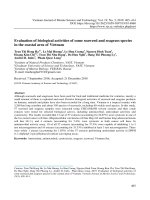Character association and path analysis for seed yield and its components in roselle (Hibiscus sabdariffa L.) in North Coastal Zone of Andhra Pradesh, India
Bạn đang xem bản rút gọn của tài liệu. Xem và tải ngay bản đầy đủ của tài liệu tại đây (183.58 KB, 7 trang )
Int.J.Curr.Microbiol.App.Sci (2017) 6(7): 372-378
International Journal of Current Microbiology and Applied Sciences
ISSN: 2319-7706 Volume 6 Number 7 (2017) pp. 372-378
Journal homepage:
Original Research Article
/>
Character Association and Path Analysis for Seed Yield and its
Components in Roselle (Hibiscus sabdariffa L.) in
North Coastal Zone of Andhra Pradesh, India
N. Hari Satyanarayana1*, V. Visalakshmi3, K.V. Ramana Murthy3,
K. Madhu Kumar3, J. Jagannadham1, A. Upendra Rao3 and N. Venugopala Rao2
1
Agricultural Research Station, Amadalavalasa, Srikakulam District, A. P. – 532 185, India
2
Regional Agricultural Research Station (North Coastal Zone),
Anakapalle, A.P. – 531 001, India
3
Agricultural Research Station, Ragolu, Srikakulam District, A. P. – 532 484, India
*Corresponding author
ABSTRACT
Keywords
Correlation,
Direct and indirect
effects, North
Coastal zone,
Roselle, Seed
yield.
Article Info
Accepted:
04 June 2017
Available Online:
10 July 2017
An experiment was conducted during kharif 2013 and 2014 in North Coastal Zone
of Andhra Pradesh at Agricultural Research Station, Ragolu, Srikakulam district to
study the character association among quantitative traits and their direct and
indirect effects on seed yield in a set of 60 genotypes of roselle (Hibiscus
sabdariffa L.). The quantitative traits pods plant-1, base diameter, seeds pod-1,
plant height, mid diameter, nodes plant-1 and test weight were found to be highly
significant and positively correlated with the dependent variable, seed yield.
Partitioning of phenotypic correlation coefficients of various components upon
seed yield plant-1 into direct and indirect contributions revealed that pods plant-1
has maximum direct effect followed by seeds pod-1 and test weight. Selection for
characters viz., pods plant-1, seeds pod-1, test weight, plant height and base
diameter along with seed yield will be useful for improving seed yield in roselle.
Introduction
Roselle (Hibiscus sabdariffa L.) belongs to
the family Malvaceae; native to Asia (India to
Malaysia) or Africa; and is an annual or
biennial plant cultivated in Tropical and SubTropical regions for its stem, fibres, edible
calyces, leaves and seeds (Mahadevan et al.,
2009). Roselle is a tetraploid species with
2n=4x=72 (Sabiel et al., 2014) and proved its
importance in fibre industries, preparation of
medicines and in culinaries to make
favourable dishes from its edible parts in
many countries. Roselle fibre blended with
jute is used in the manufacture of jute goods
viz., cordage, sacking, hessian, canvas and
rough sacks, ropes, twines, fishing nets etc.
The stalks were used in making paper pulp,
structural boards, as a blend for wood pulp
and thatching huts (Juhi Agarwal and Ela
Dedhia, 2014). Roselle seed oil is richer in
carotenoids than expensive oils like niger and
coriander seed oil (Ramada and Morsel,
2014). Carotenoids are important ingredients
in cosmetic industries due to their antioxidant
activity and protective effect on the skin
372
Int.J.Curr.Microbiol.App.Sci (2017) 6(7): 372-378
(Platon, 1997). Roselle seed flour can prevent
cancer, lower blood pressure and improve the
digestive systems in humans (Karma and
Chavan, 2017). Since, roselle is mostly used
for its fibre in India, research efforts were
made only on fibre yield and its contributing
traits by researchers till date and there is
every need to study on seed yield and its
contributing characters as seed is also being
used as raw material in many industries.
diameter (mm), days to 50% flowering, pods
plant-1, seeds pod-1, test weight (g) and seed
yield plant-1 (g). Correlations were calculated
as suggested by Johnson et al., (1955). The
phenotypic correlations were used to find out
the direct and indirect effects of the
component characters on fibre yield per plant,
according to Dewey and Lu (1959).
Generally, success of any crop improvement
program largely depends on the magnitude of
genetic variability within the traits,
relationship between the traits and also direct
and indirect contributions of these traits for
the dependant variable, yield. Correlation and
path coefficient analysis will help to identify
component characters in a breeding
programme whose selection would result in
the improvement of complex traits that are
positively correlated. Keeping this in view,
this study was conducted for assessing the
relationship between traits and evaluating the
direct and indirect contributions of these traits
to seed yield improvement in roselle.
The analysis of variance revealed significant
difference among the genotypes for all the
nine characters studied (Table 1). Phenotypic
(simple) correlation analysis is carried for all
possible combination of characters to obtain
information about relationship and intensity
existing among them. Phenotypic correlation
coefficients for different pairs of characters
are given in table 2. In 2013, highly
significant positive association of seed yield
plant-1 was observed with pods plant-1, seeds
pod-1, plant height and base diameter; whereas
in 2014 the traits pods plant-1, test weight,
mid diameter, base diameter and nodes plant-1
were highly significant with positive
association for seed yield-1. These results are
in agreement with Dastidar et al., (1993),
Islam et al., (2001), Palve et al., (2003),
Echekwu and Showemino (2004), Ali and
Sasmal (2006), Ibrahim and Hussein (2006),
Pervin and Haque (2012), Ibrahim et al.,
(2013), Rupal et al., (2017) and Shiva Kumar
et al., (2017). All the remaining traits were
non-significant with the dependent variable
seed yield and no variable was proved to be
significant in a negative direction. This
suggests selecting for the characters with high
positive correlation would improve the seed
yield in roselle.
Results and Discussion
Materials and Methods
Sixty roselle (Hibiscus sabdariffa L.)
genotypes consisting of eleven exotic lines;
four released varieties and 45 indigenous
accessions were evaluated in North Coastal
zone, Andhra Pradesh at Agricultural
Research Station, Ragolu (Latitude 180 24’ N;
Longitude 83. 840 E at an altitude of 27m
above mean sea level) during early kharif
seasons in 2013 and 2014. The experimental
trial was laid out in randomized block design
with a plot size of four rows of 2m length in
two replications with a spacing of 30 x 10cm
under rainfed conditions. Recommended
package of practices was followed to raise a
good crop. Data on the basis of five randomly
selected competitive plants were recorded on
plant height (cm), base diameter (mm), mid
Plant height exhibited significant positive
association with base diameter, mid diameter,
nodes plant-1, pods plant-1 and seed yield
plant-1 for both the years, whereas, test weight
showed
highly
significant
negative
373
Int.J.Curr.Microbiol.App.Sci (2017) 6(7): 372-378
association with plant height. Base diameter
recorded positive significant association with
plant height, mid diameter, nodes plant-1, pods
plant-1 and seed yield plant-1 for both years,
whereas, days to 50% flowering showed
significant positive relation in the year 2014
only.
flowering, pods plant-1 and seeds pod-1. From
inter-relationship studies it was evident that
pods plant-1, seeds pod-1, plant height, base
diameter, test weight, mid diameter and nodes
plant-1 were having significant positive
association for the trait seed yield, hence,
selection for these characters is fruitful.
Mid diameter exhibited positive significant
association with plant height, base diameter,
nodes plant-1 and pods plant-1, whereas, days
to 50% flowering and seed yield plant-1
showed significant positive relation in the
year 2014 only. Nodes plant-1 exhibited
significant positive association with plant
height, base diameter, mid diameter and pods
plant-1, whereas, seed yield plant-1 showed
significant positive relation in the year 2014
only; however, days to 50% flowering
showed significant negative association with
nodes plant-1.
Partitioning of correlation coefficients for
various component characters with seed yield
into direct and indirect effects (Table 3)
revealed that pods plant-1 (0.9038 and 0.9169)
has maximum direct effect on seed yield
followed by seeds pod-1 (0.3180 and 0.2144)
and test weight (0.2623 and 0.2998) which are
in conformity with Dastidar et al., (1993),
Islam et al., (2001), Echekwu and Showemino
(2004), Pervin and Haque (2012) and Rupal et
al., (2017).
High correlation coefficient of pods plant-1
(0.926 and 0.939) with seed yield was majorly
due to its own direct effect; whereas, for seeds
pod-1 (0.507 in 2013) it was due to its own
direct effects (0.3180) coupled with indirect
effects through the trait pods plant-1 (0.2634).
Similarly, high correlation coefficient of test
weight (0.330 in 2014) with seed yield was
majorly due to its own direct effect coupled
with indirect effects through the trait pods
plant-1 (0.1109).
Days to 50% flowering exhibited significant
positive correlation with plant height, base
diameter, mid diameter and pods plant-1 in the
year 2014 and negatively significant for test
weight in both years.
Pods plant-1 exhibited significant positive
correlation with all the traits except for test
weight. By this it is evident that selection for
these characters would increase the seed yield
of roselle.
Plant height recorded high correlation
coefficient (0.448) in 2013 which was due to
the indirect effects through pods plant-1
(0.4467) and seeds pod-1 (0.1008). Likewise,
for base diameter (0.330 and 0.258),
significant correlation coefficients were
majorly due to the indirect effects of pods
plant-1(0.3569 and 0.2496). Significant
correlation coefficient for mid diameter in
2014 (0.269) was majorly due to the indirect
effects through pods plant-1(0.2070) coupled
with its own direct effect (0.0485); similarly,
for nodes plant-1 (0.248) in 2014, pods plant-1
(0.2510) played significant role indirectly.
Seed pod-1 has significant positive association
with plant height, pods plant-1 and seed yield
in 2013 only and negative significant
association was recorded with test weight in
2013 and 2014; whereas, it recorded nonsignificant association for rest of the
quantitative traits.
Test weight recorded significant positive
correlation with seed yield plant-1 in 2014,
whereas, showed significant negative
association with plant height, days to 50%
374
Int.J.Curr.Microbiol.App.Sci (2017) 6(7): 372-378
Table.1 Analysis of variance for nine characters in roselle (Hibiscus sabdariffa L.) during 2013 and 2014
Source of
variations
df
Replications
1
Genotypes
59
Error
59
Year
Plant
height
(mm)
Base
diameter
(mm)
Mid
diameter
(mm)
2013
2014
2013
2014
2013
2014
104.533
342.616
2985.83**
3560.94**
295.615
348.236
2.189
1.859
7.50**
11.77**
3.152
3.117
1.587
0.126
3.67*
3.98**
2.082
1.628
Nodes
plant-1
Days to
50%
flowering
Pods
plant-1
Mean sum of squares
18.408
1.408
1.633
11.408
10.208
4.256
44.83*
118.05**
237.11**
117.17**
52.10**
56.79**
28.697
13.292
6.386
43.174
20.145
3.779
Seeds pod1
Test
weight (g)
Seed yield
(g)
0.033
0.8
27.00**
15.88**
1.784
3.135
0.008
2.269
18.24**
18.01**
1.572
2.756
0.641
0.063
55.05**
14.76**
1.332
0.814
Table.2 Phenotypic correlation coefficients between seed yield and its component characters in roselle (Hibiscus sabdariffa L.) in 2013 and 2014
Character
Plant height (cm)
2013
2014
Plant height
(cm)
1.000
1.000
Base diameter
(mm)
0.513**
0.729**
Mid diameter
(mm)
0.182*
0.651**
0.310**
0.464**
Days to 50%
flowering
-0.017
0.383**
Pods per
plant
0.494**
0.219*
Seeds per
pod
0.317**
0.135
Test weight
(g)
-0.444**
-0.329**
Seed yield
(g)
0.448**
0.139
0.100
-0.142
0.330**
Nodes / plant
Base diameter
(mm)
2013
1.000
0.238**
0.279**
-0.064
0.395**
2014
1.000
0.826**
0.509**
0.234**
0.272**
0.138
-0.089
0.258**
Mid diameter
(mm)
2013
1.000
0.429**
-0.036
0.186*
-0.022
0.038
0.160
2014
1.000
Nodes / plant
Days to 50%
flowering
Pods per plant
Seeds per pod
Test weight (g)
Seed yield (g)
0.446**
0.181*
0.226*
0.121
0.051
0.269**
2013
1.000
-0.197*
0.182*
0.040
-0.070
0.162
2014
1.000
0.143
0.274**
0.066
-0.027
0.248**
2013
1.000
-0.128
0.163
-0.234*
-0.143
2014
1.000
0.186*
-0.005
-0.262**
-0.084
2013
1.000
0.291**
-0.287**
0.926**
2014
1.000
-0.059
0.121
0.939**
2013
1.000
-0.306**
0.507**
2014
1.000
-0.400**
0.043
2013
1.000
-0.102
2014
2013
2014
1.000
0.330**
1.000
1.000
*Significant at 5% level, **Significant at 1% level
375
Int.J.Curr.Microbiol.App.Sci (2017) 6(7): 372-378
Table.3 Direct and indirect contributions of component characters for seed yield in roselle (Hibiscus sabdariffa L.) in 2013 and 2014
Character
Plant height
Base
Mid
Nodes /
Days to
Pods per
Seeds
Test weight
Correlation
(cm)
diameter
diameter
plant
flowering
plant
per pod
(g)
with seed yield
(mm)
(mm)
Plant
2013
0.0388
-0.0210
-0.0018
0.0011
0.0003
0.4467
0.1008
-0.1165
0.448**
height
2014
0.0098
-0.0217
0.0316
-0.0086
-0.0040
0.2009
0.0290
-0.0986
0.139
Base
(cm)
2013
0.0199
-0.0410
-0.0024
0.0009
0.0013
0.3569
0.0318
-0.0373
0.330**
diameter
2014
0.0072
-0.0298
0.0401
-0.0094
-0.0024
0.2496
0.0296
-0.0266
0.258**
Mid
(mm)
2013
0.0071
-0.0098
-0.0099
0.0015
0.0007
0.1678
-0.0072
0.0100
0.160
diameter
2014
0.0064
-0.0246
0.0485
-0.0082
-0.0019
0.2070
0.0259
0.0154
0.269**
Nodes
(mm) /
2013
0.0120
-0.0114
-0.0043
0.0034
0.0038
0.1643
0.0129
-0.0184
0.162
plant
2014
0.0046
-0.0152
0.0216
-0.0185
-0.0015
0.2510
0.0142
-0.0080
0.248**
Days to
2013
-0.0007
0.0026
0.0004
-0.0007
-0.0194
-0.1160
0.0517
-0.0614
-0.143
flowering
2014
0.0038
-0.0070
0.0088
-0.0026
-0.0104
0.1710
-0.0011
-0.0784
-0.084
Pods per
2013
0.0192
-0.0162
-0.0018
0.0006
0.0025
0.9038
0.0927
-0.0752
0.926**
plant
2014
0.0022
-0.0081
0.0109
-0.0051
-0.0019
0.9169
-0.0126
0.0363
0.939**
Seeds per
2013
0.0123
-0.0041
0.0002
0.0001
-0.0032
0.2634
0.3180
-0.0803
0.507**
pod
2014
0.0013
-0.0041
0.0059
-0.0012
0.0001
-0.0538
0.2144
-0.1199
0.043
Test
2013
-0.0172
0.0058
-0.0004
-0.0002
0.0046
-0.2591
-0.0974
0.2623
-0.102
weight (g)
2014
-0.0032
0.0026
0.0025
0.0005
0.0027
0.1109
-0.0857
0.2998
0.330**
Bold: Direct effects, Residual effect: 2.34% (2013) and 4.01% (2014)
376
Int.J.Curr.Microbiol.App.Sci (2017) 6(7): 372-378
The value of residual effects was low (2.34%
and 4.01%) suggesting that most of the total
variations for seed yield in roselle were
explained. Finally, the path coefficient
analysis revealed importance of pods plant-1,
seeds pod-1 and test weight for their
contribution either directly or indirectly to
seed yield and hence, during selection these
traits should be given utmost attention for
developing of high seed yielding roselle
varieties.
326.
Ibrahim, E.B., Abdel, W.H.A., Elshiekh, A.I.
and
Ahmed
M.E.N.
2013.
Interrelationship between yield and its
components in some roselle (Hibiscus
sabdariffa L.) genotyoes. World J.
Agric. Res., 1(6): 114-118.
Ibrahim, M.M. and Hussein, R.M. 2006.
Variability, heritability and genetic
advance in some genotypes of roselle
(Hibiscus sabdariffa L.). World J.
Agric. Sci., 2(3): 340-345.
Islam, M.S., Uddin, M.N., Haque, M.M.,
Islam, M.N. 2001. Path coefficient
analysis for some fibre yield related
traits in white jute (Corchorus
capsularis L.). Pakistan J Biological
Sci. 4(1): 47-49.
Johnson, H.W., Robinson, H.F. and
Comstock, R.F. 1955. Estimates of
genetic and environmental variability in
soybean. Agron. J., 47: 314-318.
Juhi Agarwal and Ela Dedhia 2014. Current
scenario of Hibiscus sabdariffa (Mesta)
in India (Maharastra). The Inter. J.
Social Sci. Humanities Invention 1(3):
129-135.
Karma, B.R. and Chavan, U.D. 2017.
Antioxidant Activity and Nutritional
Value of Roselle Seeds Flour. Int. J.
Curr. Microbiol. App. Sci., 6(4): 26542663.
Mahadevan, N., Shivali and Pradeep, K.
2009. Hibiscus sabdariffa Linn. – An
overview. Natural Product Radiance
8(1): 77-83.
Palve, S.M. and Sinha, M.K. 2005. Genetic
variation and interrelationships among
fibre yield attributes in secondary
genepool of Corchorus spp. SABRAO J.
Breeding and Genetics, 37(1): 55-64.
Pervin, N., Haque G.K., 2012. Path
coefficient analysis for fibre yield
related traits in Deshi jute (Corchorus
capsularis L.). IRJALS, 1(3): 72-77.
Platon, J.F. (1997). Lipids in Cosmetology.
In conclusion, based on character association
and path analysis studies seed yield plant-1
may be improved by selection of tall plants
coupled with high pods plant-1 having strong
base and mid diameter with more number of
seeds and high test weight.
Acknowledgement
The authors are highly thankful to the
authorities of ANGRAU, Andhra Pradesh for
providing necessary help and infrastructural
facilities to undertake this study.
References
Ali, M.N. and Sasmal, B.G. 2006. Association
of seed yield and its components in
segregating population of tossa jute
(Corchorus olitorius). Agric. Sci.
Digest, 26(3): 206-208.
Dastidar, K.K.G., Agarwalla, K.K. and
Roychowdhury P. 1993. Genetic
variability and association component
characters for seed yield in Olitorius
jute. Indian J. Genet., 53(2): 157-160.
Dewey, D.R. and Lu, K.H. 1959. A
correlation and path coefficient analysis
of components of crested wheat grass
seed production. Agron. J., 51: 515-518.
Echekwu, C.A. and Showemimo, F.A. 2004.
Genetic, Phenotypic and environmental
variances and character association in
kenaf. African Crop Sci. J., 12(4): 321377
Int.J.Curr.Microbiol.App.Sci (2017) 6(7): 372-378
Ol. Corps. Gras. Lipid, 4: 275-281.
Ramadan, M.F. and Morsel, J.T. 2004.
Oxidative stability of black cumin
(Nigella
sativa
L.),
coriander
(Coriandrum sativum L.) and niger
(Guizotia abyssinica Cass.) crude seed
oils upon stripping. Eur. J. Lipid Sci.
Technol., 106: 35-43.
Rupal, D., Modha, K.G., Dhirendra Kumar
and
Meenakshi
Dhoot.
2017.
Correlations and Path analysis studies
on yield and its components in
Mungbean
(Vigna
radiata
(L.)
Wilczek). Int. J. Curr. Microbial. App.
Sci. 6(5): 370-378.
Sabiel, S.A.I., Ismail, M.I., Osman, A. and
Sun, D. 2014. Genetic variability for
yield and related attributes of roselle
(Hibiscus sabdariffa L.) genotypes
under rainfed condition in a Semi-arid
zone of Sudan. Persian Gulf Crop
Protection 3(1): 33-40.
Shiva Kumar, K., Nidagundi, J.M. and
Hosamani, A.C. 2017. Correlation
analysis
for
Agro-Morphological
Features in Upland Cotton under rainfed
conditions. Int. J. Curr. Microbiol. App.
Sci. 6(5): 2593-2596.
How to cite this article:
Hari Satyanarayana, N., V. Visalakshmi, K.V. Ramana Murthy, K. Madhu Kumar, J.
Jagannadham, A. Upendra Rao and Venugopala Rao, N. 2017. Character Association and Path
Analysis for Seed Yield and its Components in Roselle (Hibiscus sabdariffa L.) in North
Coastal Zone of Andhra Pradesh, India. Int.J.Curr.Microbiol.App.Sci. 6(7): 372-378.
doi: />
378
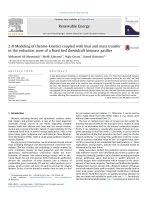
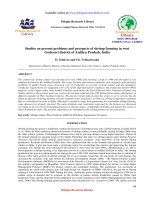
![Heterosis studies for seed yield and earliness in intra-specific hybrids of ricebean [Vigna umbellata (Thunb.) ohwi and ohashi] an under utilized pulse](https://media.store123doc.com/images/document/2020_01/09/medium_pxu1578554402.jpg)

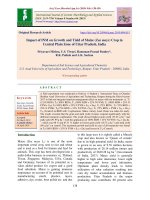
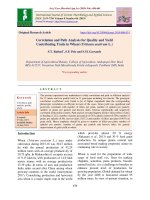
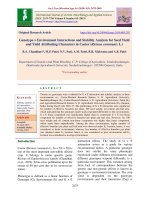
![Studies on correlation and path analysis for grain yield and quality components in foxtail millet [Setaria italica (L.) Beauv.]](https://media.store123doc.com/images/document/2020_01/09/medium_dyd1578574836.jpg)
